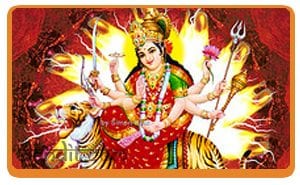Durga Ashtami and its auspicious celebration in India

What is the story behind celebrating ‘Durga Ashtami’?
The eighth day of ‘Navratri’ is celebrated as ‘Durga Ashtami’. It is also called, ‘Mahashtami’ and is one of the important days of ‘Durga Pooja’. This festival is celebrated to mark the victory of Goddess Durga on the demon ‘Mahishasur’. The day is also called ‘Virashtami’ as the weapons of Goddess Durga are worshipped this day, seeking power from the divine. There are two Durga Ashtami days, which are celebrated in the country, one of them being called as ‘Chaitra Durgashtami’ and the other one as ‘Ashwin Ashtami’.
According to the folklore, Goddess Kali (Incarnation of Goddess Durga) appeared from the forehead of Goddess Durga on this day to eliminate demons, ‘Chanda’, ‘Munda’ and ‘Rakthabheej’. It is also considered pious to worship the 64 ‘Yoginis’ and ‘Ashtavinayaks’, the eight consorts of Goddess Durga. The eight consorts of Goddess are named as under: Brahmani, Maheswari, Kameswari, Vaishnavi, Vaarahi, Narasinghi, Indrani and Chamunda. Devotees visit the various temples or ‘Shakti Peeths’ all over the country to pray the deity.
What is the significance of ‘Durga Ashtami Pujan’?
Durga Ashtami pujan is considered as one of the most important festivals in India. It is celebrated for ten days in which Goddess Durga is worshipped. Goddess Durga is the Goddess of Power or Shakti. She is worshipped in every Hindu family in nine different forms. Durga Ashtami pujan is celebrated all over in India but it is celebrated in northern areas of India such as West Bengal, Bihar, Orissa and Tripura with more enthusiasm and fun. This festival is considered as highly auspicious festival especially in northern belt of India. Grand celebration of 9 days is associated with the famous and rich community of west Bengal in 16th Century. This community is now widely spread in West Bengal and they celebrate this festival with such enthusiasm in present time also. According to time, Rituals are changed but celebration becomes more enthusiastic.
Other name associated with Durga Puja is Durgotsav and Navratra. The last six days of ten days are best for celebration. People gather for the celebration on last six days and follow all the rituals of Durga puja. On the first day of Navratra, kalash is kept at home by the devotees. Celebration starts from first day itself. People worship Maa Durga and install a Kalash in home area. Real celebration of Durga Ashtami begins with the day of Mahalaya. After this, from the morning of sixth day of Durgotsav, procedure of offering flowers or Pushpanjali to Maa Durga takes place. People chant Aarti while doing Pooja and offer food or bhog to Maa Durga. Generally, nine types of food items and nine types of flowers are offered. Saptami, Ashtami and Namvi of Navrata are considered as Maha Saptami, Maha Ashtami and Maha Namvi respectively. They are celebrated as special ceremonies. Between the time of Maha Ashtami and Maha Navami, Sandhikshan ceremony takes place. It is an important ceremony of Durgotsava in which earthen lambs are lightening all over the night in the form of rows. It is believed in Vedas that, it is an auspicious activity to feed nine girls on the day of Maha Navami.
The traditions to perform Durga Pooja differ from state to state. In Gujarat, major activity that takes place in Navaratra is Garba and Dandiya. In West Bengal, Drum beats are mainly focused in Navratra. There is a special drum called as Dhak that is used in West Bengal to perform majestic rhythm. This drum mesmerizes the heartbeats of crowd in Kolkata, West Bengal.
What rituals are to be followed for performing ‘Durga Ashtami Pujan’?
Devotees of Goddess get nine earthen pots and invoke the Goddess Durga and her eight consort’s imags in the pots. The general tradition of calling nine young unmarried girls, at home and treating them like Goddesses is quite prevalent in the northern part of the country. This ritual is called ‘Kumari Pooja’ or ‘Kanya Pooja’. ‘Navami Homa’ is also considered a sacred ritual and devotees perform this to seek Goddess Durga’s blessings.
What are the items that are required for the ‘Durga Pooja’?
A picture or an idol of Goddess Durga, A red colored ‘Dupatta’ or Saree to be offered to the deity, Durga Saptshati book, Holy Ganga water in a ‘Kalash’, mango leaves, Fresh grass, sandalwood, coconut, ‘Roli’, ‘Moli’, rice grains, ‘supari’, ‘paan’ leaves, cloves, cardamom, kumkum (vermillion) and ‘gulal’.
What mantra to be chanted while doing ‘Durga Pooja’?
“Ya Devi Sarvabhuteshu Shakti Rupen Sansthita, Namstasaya Namstasaya Namstasaya Namoh Namah”, which means O goddess, salutations to you who is abiding in the form of power.
What are the steps one has to follow while performing the ‘Durga Pujan’?
- One should take shower during the ‘Brahmamurat’ and wear neat and clean clothes.
- After that, they pray to the deity Goddess Durga with ‘Dhoop’, ‘Roli’, ‘kumkum’, ‘flowers’, ‘akshat’, and ‘diya’.
- One has to make, ‘Halwa Puri and chana’ and offer it to the deity. One can also include Indian sweet, ‘Mawa’ as ‘prasad’.
- After offering the above, one should take some flowers in his/her hand and chant the following Shloka, “Sarva Mangala Maangalye, Shive Sarvaartha Saadhike, Shranye
- After offering these flowers to the deity, one should recite ‘Durga Chalisa’. In the end, sing ‘Durga Aarti’.
According to tradition, unmarried young girls (5, 7, 9 or 11 girls) along with 1 ‘langura’ (a boy below 7 year of age) are called at home and worshipped. Their feet are washed with holy water and ‘prasad’ of ‘halwa, chana and puri’ is served to them. On the auspicious day, ‘diya’ made of flour is made and placed in the middle of the ‘prasad’ plate. Once the holy ‘diya’ is lit, one should not clean the house or wash clothes. The food cooked in the kitchen should not have onion or garlic.